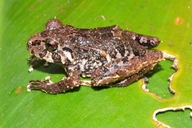
Assessment Results
Pristimantis calcaratus
Order:
Anura
Family:
Craugastoridae
Synonym(s):
Eleutherodactylus calcaratus, Hylodes calcaratus
Assessed for:
Colombia
on:
30 Nov 2017
by:
Carlos Eduardo Burbano Yandi
IUCN Global Red List:
Endangered (EN)
National Red List:
(not assessed)
Distribution:
Colombia
Evolutionary Distinctiveness score:
18.18547678
Recommended Conservation Actions:
Additional Comments:
Nombre común en Inglés - San Antonio Robber Frog
Fernando Castro, María Isabel Herrera, John Lynch. 2004. Pristimantis calcaratus . La Lista Roja de Especies Amenazadas 2004 de la UICN: e.T56487A11473279. http://dx.doi.org/10.2305/IUCN.UK.2004.RLTS.T56487A11473279.en . Descargado el 30 de noviembre de 2017 .
García-R., JC, AM Mendoza, OE Ospina, H. Cárdenas-Henao y F. Castro-Herrera. 2014. Un enfoque morfométrico y molecular para definir tres especies estrechamente relacionadas de ranas del género Pristimantis (Anura: Craugastoridae) de la Cordillera Occidental en Colombia. Journal of Herpetology 48: 220-227.
| Question # | Short Name | Question Text | Response | Comments |
| 1 | Extinction risk | Current IUCN Red List category. [Data obtained from the IUCN Red List.] | Vulnerable (VU) | RL 2017 |
| 2 | Possibly extinct | Is there a strong possibility that this species might be extinct in the wild? | No / unlikely | Existen registros de poblaciones en los departamentos de Risaralda y Valle del Cauca, su registros son desde 1991, en el municipio de El Cairo, Dagua, Riofrio, Cali y La Cumbre. El grupo de investigación y ecologia animal de la Universidad del Valle, tiene registro de esta especie desde el 2015, en varias Reservas Forestales Protectoras Nacionales. Curiosamente, en el Instituto de Ciencias Naturales (ICN) se tienen registro de colectas de 1984, para el departamento de Nariño haciendo necesaria su corroboración. |
| 3 | Phylogenetic significance | The taxon’s Evolutionary Distinctiveness (ED) score, as generated by the ZSL EDGE program. (These data are not editable by Assessors). | ED value < 20 | |
| 4 | Protected habitat | Is a population of at least 50% of the individuals of the taxon included within a well-managed or reliably protected area or areas? | Yes / probably | PNN Farallones de Cali, Reserva Forestal Bitaco, Reserva Forestal El Duende. |
| 5 | Habitat for reintroduction, conservation translocation or supplementation | Does enough well-managed and reliably protected habitat exist, either within or outside of currently protected areas that is suitable for conservation translocation, including population restoration or conservation introduction? | Yes / probably | A pesar de que su distribución abarca un gran número de áreas protegidas, las zonas por fuera de estas se encuentran con ecosistemas transformados donde también se ha reportado la presencia del hongo quitridiuum. PNN Farallones de Cali, Reserva Forestal Bitaco, Reserva Forestal El Duende. |
| 6 | Previous reintroductions | Have reintroduction or translocation attempts been made in the past for this species? | No | |
| 7 | In situ conservation activities | Are any in situ conservation actions currently in place for this species? (Only required if a Red List Assessment has not been completed, or if new actions have been implemented since the last Red List Assessment. (Information from the Conservation Actions section of the Red List assessment should be reviewed and considered when answering this question.). | ||
| 8 | In situ conservation activities | Are additional in situ conservation actions required to help conserve this species in the wild (e.g. habitat restoration and/or protection, control of invasive species, national legislation etc.)? | ||
| 9 | In situ research | Is additional in situ research required to better understand the species, e.g. distribution, population trends, natural history etc.? | ||
| 10 | Threat mitigation | Are the threats facing the taxon, including any new and emerging threats not considered in the IUCN Red List, potentially reversible? | Threats are likely to be reversible in time frame to prevent further decline / extinction | Según Castro y Bolivar 2010, la principal amenaza de la especie es la pe´rdida de ha´bitat causada por el desarrollo agropecuario y la plantacio´n de cultivos ili´citos, además de los múltiples proyectos sectoriales y minero energéticos que se proyectan sobre toda su área de distribución. Algunas de estas amenazas pueden ser abordadas desde las áreas protegidas, pero son pocas las cuales pueden hacer frente a los proyectos sectoriales, de minería e hidrocarburos. De igual forma, la presencia del hongo quitridium es otra de las amenazas que presenta esta especie, localidades en el municipio de El Cairo, como el cerro del ingles, tienen este patógeno. |
| 11 | Over-collection from the wild | Is the taxon suffering from collection within its natural range, either for food, for the pet trade or for any other reason, which threatens the species’ continued persistence in the wild? | No / unlikely | |
| 12 | Population recovery | Is the known population of this species in the wild large enough to recover naturally, without ex situ intervention if threats are mitigated? | Yes / probably | |
| 13 | Action plans | Does an Action Plan for the species already exist, or is one currently being developed? | ||
| 14 | Biological distinctiveness | Does the taxon exhibit a distinctive reproductive mode, behaviour, aspect of morphology or physiology, within the Order to which it belongs (e.g. Anura, Passeriformes etc.)? | No aspect of biology known to be exceptional | |
| 15 | Cultural/socio-economic importance | Does the taxon have a special human cultural value (e.g. as a national or regional symbol, in a historic context, featuring in traditional stories) or economic value (e.g. food, traditional medicine, tourism) within its natural range or in a wider global context? | No | |
| 16 | Scientific importance | Is the species vital to current or planned research other than species-specific ecology/biology/conservation within the Order to which it belongs (e.g. Anura, Passeriformes etc.) e.g. human medicine, climate change, environmental pollutants and conservation science? | No research dependent on this species | |
| 17 | Ex situ research | Does conserving this species (or closely related species) in situ depend upon research that can be most easily carried out ex situ? | No | Las poblaciones de esta especie se consideran con una tendencia a la disminución, no obstante, las amenazas que están ocasionando una presión sobre esta especie se pueden abordar ex situ, desde la gestión de las áreas protegidas y el ordenamiento ambiental de las cuencas donde se le reporta, junto con la investigación básica y la evaluación poblacional. |
| 18 | Ex situ conservation activities | Is any ex situ research or other ex situ conservation action currently in place for this species? (Information from the Conservation Actions section of the Red List assessment should be reviewed and considered when answering this question.) | ||
| 19 | Husbandry analog required | If an ex situ rescue program is recommended for this species, would an analog species be required to develop husbandry protocols first? | ||
| 20 | Husbandry analog | Do the biological and ecological attributes of this species make it suitable for developing husbandry regimes for more threatened related species? i.e. could this species be used in captivity to help to develop husbandry and breeding protocols which could be used for a similar, but more endangered species at a later stage? | No | |
| 21 | Captive breeding | Has this species been successfully bred and/or maintained in captivity? | Not held in captivity to date | |
| 22 | Conservation education/ecotourism potential | Is the species especially diurnal, active or colourful, or is there an interesting or unusual aspect of its ecology that make it particularly suitable to be an educational ambassador for conservation of the species in the range country, either in zoos or aquariums or within ecotourism activities? | No | |
| 23 | Mandate | Is there an existing conservation mandate recommending the ex situ conservation of this taxon? | No | |
| 24 | Range State approval | If an ex situ initiative was proposed for this species, would it be supported (and approved) by the range State (either within the range State or out-of-country ex situ)? | Yes / probably | |
| 25 | Founder specimens | Are sufficient animals of the taxon available or potentially available (from wild or captive sources) to initiate an ex situ program, if one was recommended? | Yes / probably | |
| 26 | Taxonomic status | Has a complete taxonomic analysis of the species in the wild been carried out, to fully understand the functional unit you wish to conserve (i.e. have species limits been determined)? | Yes | García-R., Mendoza, Ospina, Cárdenas-Henao, y Castro-Herrera, 2014, J. Herpetol., 48: 220-227, compararon morfologica y geneticamente (COI y 16 S) esta especie con otras dos relacionadas filogenéticamente, que fueron Pristimantis kelephas y Pristimantis jubatus, revelando que son especies bien delimitadas. |
Citation:
Carlos Eduardo Burbano Yandi. 2017. Conservation Needs Assessment for Pristimantis calcaratus, Colombia.
https://www.conservationneeds.org/assessment/4254
Accessed 02 May 2025






